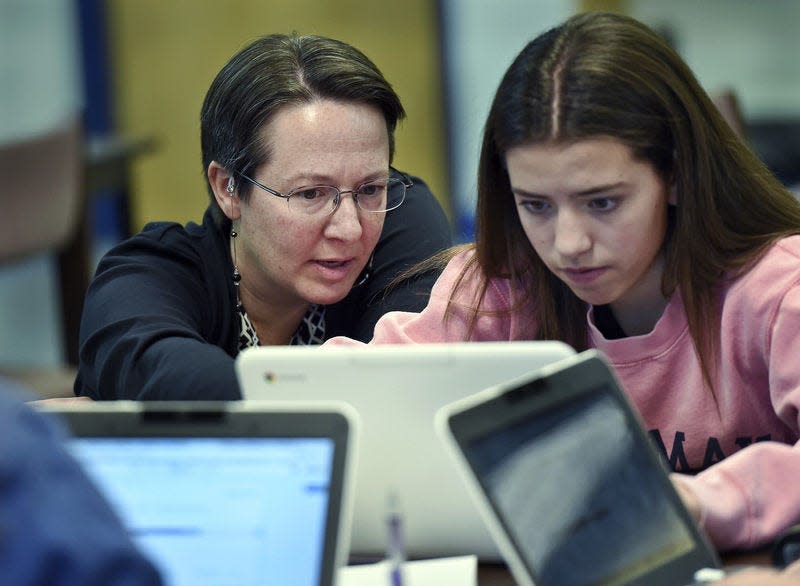Recognizing fake news: Media literacy now required subject in California schools
- Oops!Something went wrong.Please try again later.
California schools are now required to teach students how to recognize "fake news" by incorporating media literacy into lessons in English, science, math, and history classes throughout every grade level.
The bill was introduced by California State Assembly member Marc Berman in February and signed by Gov. Gavin Newsom on Oct. 13.
The bill expands on previous laws requiring that the State Department of Education post resources and instructional materials on media literacy on its website for school district to access.
Now, media literacy will be incorporated into standards for English, science, math and history when the standards are revised after Jan. 1.
States such as New Jersey, Illinois and Delaware also require media literacy lessons for students, Berman said on his website.
At least 18 state legislatures have made steps to prioritize media literacy education in schools, said Erin McNeill, founder and CEO of Media Literacy Now. Her Massachusetts-based organization pushes for media literacy education in schools.
Washington state is making some notable moves surrounding media literacy, she said.
The state has funded teacher training and professional development. The state also has someone within its education agency who focuses on media literacy and how to implement it in the classroom.
Satan club: Parents in a Connecticut town worry as 'After School Satan Club' plans meeting
Understanding the media literacy bill
The bill to incorporate media literacy was introduced in February largely because legislators want to make sure students can ask and answer questions about the “moral obligations and ethical standards regarding what appears on social media networks and digital platforms,” the bill’s text reads.
With so many young people online − more than 90% − legislators said social media will continue to reach and influence them.
A huge part of the problem, the bill’s text argues, is that many young people can’t tell the difference between ads and news stories. Citing a study out of Stanford University, Berman said in the bill’s text that 82% of middle schoolers couldn’t tell the difference between ads and news stories.
On his website, Berman also cited a 2019 Stanford University study in which more than half of the high school students surveyed thought a “grainy” video that claimed to show ballot stuffing was “strong evidence” of voter fraud in the U.S.
The video was filmed in Russia, Berman said.
And with misinformation on the rise, the bill will seemingly give legislators a way to combat online misinformation and its interference with democratic decision-making and public health.
Berman said in the bill’s text that before this bill, there were no lessons put in place to help students become more information-literate. With this bill signed into law, students from kindergarten through 12th grade will have the opportunity to brush up on their media literacy skills, the bill says.
Media literacy organization stresses the need for classroom implementation, evaluation
California’s law received bipartisan support and will ensure that students as young as kindergarten will be introduced to media literacy in some form.
What media literacy with younger students looks like may involve asking questions, said McNeill from Media Literacy Now.
“'Who created this?'” she said. “'What is it telling me? What does it want me to do?' What I used to do with my kids before they were in kindergarten is to ask them about a toy commercial that they're seeing and the toy packaging that they’re seeing: 'Does that toy really do that?'”
She said California’s plan looks promising, largely because it includes frameworks that will help shape state resources. The state will vet these resources and put funding towards teacher training, she said.
California’s most recent steps aren’t just about news, she said.
“I think a big part of this is social media,” she said. “This is about who's contacting me on social media. When I put a message out on social media, what does that say about myself?”
There are also social media issues involving bullying, dangerous challenges and, in many cases, sexual extortion of teenage boys, she said.
She would like to see legislators tackle evaluation measurement and look into how students are learning media literacy, where it is being taught, which school districts are doing a good job at it and where more attention is needed.

Native American heritage and schools: Hair length policy at Kansas school sparks backlash after Native American boy, 8, forced to cut hair
Recognizing 'fake news,' misinformation
Legislators want to make sure all students in California have the media literacy skills they need to “critically consume and use social media and other forms of media.”
Berman said on his website that misinformation can have “terrifying” effects on the real world, citing climate denial, vaccine conspiracy theories and other “deadly consequences.”
“We have a responsibility to teach the next generation to be more critical consumers of online content and more guarded against misinformation, propaganda, and conspiracy theories,” he said. “In addition, this instruction will help students to be more responsible digital citizens, more intentional about what they put online, and better understand online safety and privacy.”
This article originally appeared on USA TODAY: Fake news classes: Media literacy to be taught in California schools

